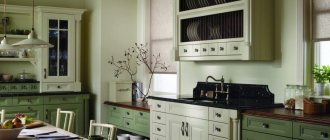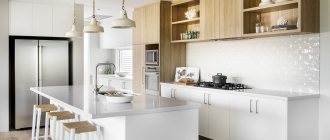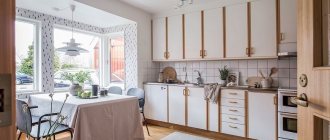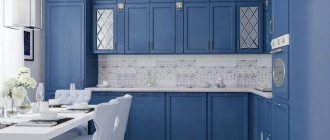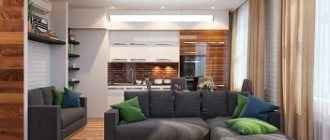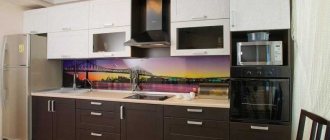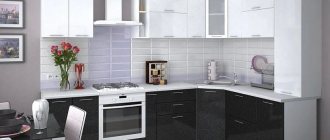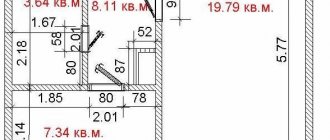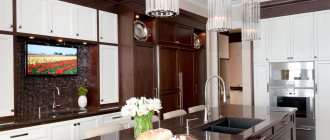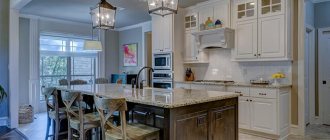A kitchen with an island is suitable for rooms with a large area of at least 15 sq. m, optimally 20-23 sq. m. The space can be isolated or connected to the living room; the layout is also popular in private houses or country houses. Convenient furniture arrangement helps to use the work surface with maximum benefit and comfort.
What is an island in the kitchen and why is it needed?
The autonomous part of the kitchen unit, which is located separately from the wall cabinets, is called an island. The design looks like a medium or large base cabinet with a countertop. It can have several shelves inside, both open and closed. Tabletops can be not only straight, but also two-level, the high part plays the role of a bar counter; such designs are called archipelagos.
Two-level archipelago
Functionally, the kitchen island has several options for its purpose:
- Most often, an island structure is used as part of a work area. The countertop is spacious and convenient for preparing food for cooking.
Additional work area
- If you install a sink or hob in the island, it becomes one of the “vertices” of the working triangle: refrigerator, stove, sink. This version of a kitchen with an island is being implemented in a private house; in urban conditions it is difficult to coordinate and transfer communications to the central part of the room.
Idea! If you move the hob to an island structure, you will need to install a recirculating hood; it does not require a ventilation duct.
- A large tabletop can also be a dining table or a bar counter. The large tabletop can comfortably accommodate up to 8-12 people at once. They also use various forms of island design and two-level countertops.
Feature Set
The functionality of the kitchen island is determined by the desire of the hostess. You can use the centerpiece for meal prep or food preparation only, or transform the island into a comfortable dining area.
Hob and sink located on the island.
How can you equip your countertop based on your own needs?
- Hob and sink. They need to be separated by a small work area. For ease of use, it should not be less than thirty centimeters.
- Combination of hob and cutting table. In this case, the cutting area is located closer to the sink mounted against the wall.
- A place for preparing food and a spacious two-section sink. A good option for a large family, when two or three housewives prepare lunch or dinner.
- Small sink, work space and hob. A common option is when the owners assign the island fragment the role of an active work area. A large sink is installed against the wall.
- Dining area equipped with small appliances. Toasters, microwaves, and a coffee maker are useful for breakfast, for a quick snack, and for evening gatherings with friends.
Advantages and disadvantages of island layout
Pros of the layout:
- A kitchen island can be used for different needs. This can house appliances, a dining area, or organize storage, including a bar.
- The island design becomes an element of space zoning, which is necessary for a kitchen combined with a living room or dining room.
- The design of a kitchen with an island layout is stylish and will remain relevant for a long time.
- Spacious, occupies 1-2 sq. m, a lot of dishes and kitchen utensils can be placed inside it.
- Can act as a place for snacks or a dining table.
- In the studio kitchen, where many guests gather, you can perform two tasks at the same time - prepare food and communicate with them.
- Large islands in the kitchen look massive and heavy; you can make them visually lighter by making the side panels glass and equipping them with shelves.
Minuses:
- A dining table made from an island is not the most comfortable; it is necessary to leave more legroom.
- To install an island structure, you will need at least 2 square meters of area, taking into account the free space for passage.
Types of islands for the kitchen
There are two types of kitchen islands:
- Stationary. Installed in a specific location, according to the layout. It is impossible to move such a structure; often there is an additional connection with communications.
- Mobile. Small islands on wheels that can be moved around the kitchen, moved if necessary, or transported to another room.
- Peninsula - one of the sides is moved towards the wall or furniture;
A kitchen island can have different shapes:
- rectangle and square - standard shape, convenient and versatile, suitable for any kitchen;
- L-shaped, with original radius facades;
- a circle is an unusual option, the safest, there is no threat of hitting a corner;
- semicircle - installation will require a large kitchen area, most often used for private homes;
- angle - suitable for small kitchens, allows you to free up space for movement, in a studio apartment it will help to separate functional areas;
- two-level - an option for placing a bar counter on a higher level or for installing a stove on a lower level.
Ergonomics and dimensions of the kitchen island
The size of a kitchen with an island may vary, but there are several features that need to be taken into account in order to use it comfortably:
- There must be at least 1 m of space between the kitchen unit and the island so that cabinet doors can open without obstruction.
- The minimum width and length of the island structure is 70 cm. There is no maximum limit, the parameters depend on the capabilities of the room.
- The width of the cabinet with a blank wall is 0.6 m. If cabinets and shelves are built in on both sides, the width is 0.9 - 1.2 m. Drawers have a depth of up to 55.5 cm.
- The height of the kitchen island that is comfortable for work is 90 cm. The side with the bar counter can reach 120 cm, on average it is 100 cm. A cabinet with a sink and hob will be massive, from 90 cm wide, from 210 cm long. The height of the chairs is 58-61 cm .
When arranging a kitchen with an island, the lines of the work area connecting the three centers of activity of a person preparing food - a stove, a sink, a refrigerator - created a triangle. The length of each side must be no less than 120 and no more than 270 cm.
What material can a kitchen island be made of?
Kitchen island materials:
- The most popular option is MDF coated with enamel. The material is resistant to temperature changes, is not afraid of humidity, and is durable. There are many colors to suit any style of kitchen interior.
- An island made of solid wood is used in spacious kitchens or those combined with a living room, as the structure is large. Careful care of the material will be required, as it is sensitive to aggressive kitchen environments.
- The island structure made of natural stone is heavy; it is recommended to use it in the kitchen of a private house on the ground floor. It looks stylish, noble, marble and onyx are trendy. This also includes brickwork.
- Stainless steel, rarely used, is suitable for kitchens in modern urban styles.
Kitchen layouts with island
Designers offer several options for decorating the interior of a kitchen with an island; for this they use different furniture layouts. Each combination has its own characteristics.
Linear
A linear or straight layout of a kitchen unit is suitable for a small kitchen, for example 15 sq. m. It is necessary to preserve the working triangle, so the island is often used to install a stove or sink. The kitchen set itself is located along one of the walls, opposite it, an island structure is placed at a safe distance, or a tabletop is attached to it at the end and you get a dedicated dining area.
Corner
A corner or L-shaped layout is used in a small kitchen; it is also suitable for an area of less than 15 sq. m; it allows you to save maximum free space, a functional and ergonomic solution. The island here is used small, most often as an additional work area. If there is not enough space, it can be modified as a dining table.
U-shaped
The U-shaped layout of the kitchen unit is suitable for a spacious kitchen combined with a living room or for the first floor of a private house. The island takes up a lot of space, its dimensions range from standard 90 by 180 cm and larger, they use countertops for several functions and two-level designs.
LiveInternetLiveInternet
Quote from shaherezada_decor
Read in full In your quotation book or community!
Kitchen with island.
How to design? I am designing a kitchen with an island. Let's cover the topic...
A kitchen island is a U- or L-shaped kitchen with a small island of kitchen furniture in the center. This kitchen interior layout is recommended for fairly large rooms, because... It is necessary to ensure that two people can move freely in the kitchen.
A distance of 2 meters from the island to the main furniture group of your kitchen (passage) is considered convenient. Minimum 1200. Firstly, the facades on both sides are usually located below (if they are 60 cm, they can meet), and secondly, 1200 is the minimum distance between the cabinets to which you need to bend.
You can place a cutting surface, a small refrigerator or freezer, a sink, a gas stove or a cooktop on the island. But remember that to install all these “delights” you will need to bring all the necessary communications (electricity, water, sewerage and gas) to your island. In this case, you will probably have to lay everything under the floor.
If you don’t really want to bother with wiring connections to your island, then you can use it as a cutting surface or additional space for storing dishes.
You can also install small wall-mounted open cabinets-shelves above the island, but in this case you will have to think about a system for attaching them to the kitchen ceiling, and the cabinets themselves will need to be made to order. And don't forget about kitchen lighting. With this design of your kitchen, lamps will need to be placed around the entire perimeter, because... the center of the ceiling is already occupied by you.
If you are going to have meals on your “island”, keep in mind that its height is usually equal to the height of the working surface, and this is significantly higher than a regular dining table (70-76cm). Bar stools that are taller than usual will help you avoid inconvenience. As a rule, they can be bought together with a kitchen set.
You can divide the kitchen island into two or more functional interior groups. For example, on one side there is a cutting surface and a built-in refrigerator or sink, and on the other there is a small table for breakfast.
It is worth considering that when designing your kitchen in the form of an island, you must strictly follow the triangle rule. Those. concentrate all the components of the triangle (refrigerator, sink, work table and stove) in one kitchen area.
At the same time, you will get a surprisingly compact work triangle, and you can use the rest of the workspace of the kitchen interior at your discretion. For example, for built-in household appliances or as additional storage space.
It is not necessary that the island be strictly rectangular or square in shape. Play up the details of your kitchen interior using the complex shape of the island.
An island is a great chance to have two different height work surfaces in your kitchen. It is customary to build the main line of a modern kitchen without transitions of floor furniture cabinets in height, but no one will stop you from making the island itself higher or lower than the main furniture. This technique is suitable for families in which not all family members are satisfied with the standard height of floor cabinets of 90 cm.
About a kitchen with an island from the site IVD.ru
https://www.ivd.ru/document.xgi?id=6089
Ergonomics
The main aspect of ergonomics is the optimal organization of areas of greatest activity. The sink is the most important of these places: here you spend 40-60% of your “kitchen” time. The ideal option is to locate it in, at a distance of 1200-1800 mm from the stove and 1200-2100 mm from the refrigerator.
Freezers and refrigerators are placed in the corners of the kitchen so as not to “tear” the work surface. On average, the area of the said triangle is about 7 m2. If the width of the kitchen is more than 4.5 m, then the distance between the appliances (with a linear layout) becomes significant, and the owners are forced to constantly move between the stove, sink and refrigerator. “Island” and “peninsular” layouts are the most suitable way to reduce the distance between functional areas.
Unlike the “island”, open on four sides, the “ peninsula ” is a kind of protrusion or bend in the line of a single-row or L-shaped kitchen (including a closed one). It is appropriate when it fits into a multifunctional space (kitchen-dining room, kitchen-living room, etc.). As a rule, a “peninsula” separates the kitchen area from the adjacent area and acts as a bar counter or serving table. In principle, its dimensions can be any.
What is located on the “island”?
The free-standing element can be used for any type of cooking activity. Here are the most common options for completing a work surface.
• Take out the hob and sink, separated by a tabletop at least 300 mm wide. • “Island” is equipped with a hob and cutting surface. The sink remains against the wall. • The “island” contains a large sink and cutting area. However, you will not have a dish dryer (in the cabinet above the sink). True, it is recommended to store utensils in specially designed lower drawers. • The “island” is equipped with a hob, a cutting surface and a sink with a diameter of 380 mm (you can wash glasses, teaware, and fruit in it); the main sink is located against the wall. • The working surface of the “island” can consist of a cutting area and a compact sink. • The entire “island” serves as additional work area. If you combine it with a bar counter, a table for a quick meal or a dining table and bring it to the “island” of sockets, then you can move household appliances here: a juicer, a kettle, a coffee machine, a toaster. The result is a well-equipped place for breakfast.
Our fellow citizens most often use “islands” as a bar counter, an additional cutting surface, or for zoning space. In this form they are more popular than as a technological part of the kitchen.
Since “islands” and “peninsulas” are often part of a residential interior, from the kitchen side they are arranged functionally, and from the living room side they are organically integrated into the recreation area. For example, the lower part is made completely closed or open, combined (on one side - ordinary cabinets, on the other - false doors), with drawers for various purposes; it is decorated with illuminated stained glass windows, and there are cells for bottles.
A dishwasher, an oven, a wine cabinet, and a compact refrigerator without a freezer are sometimes built under the “island” countertop (it is appropriate in the cooking area when there is a large refrigerator in a remote part of the spacious kitchen). Above the remote unit, a decorative shelf attached to the ceiling—mensola—looks impressive (it can be supplied complete with a hood and lighting), visually balancing the massive structure of the “island.” Everything that is usually located above the work surface in full view of the housewife is hung from it, including utensils - frying pans, pots, saucepans...
Snaidero
Expert opinion
An “island” kitchen is ideal in a large room (15-18 m2 or more). Designers recommend highlighting food preparation and food preparation areas here. The first of them contains the main work surface (between the sink and the stove); it should be sufficiently long and well lit. An island table is best suited for this. In the case where a sink is located on it, the distribution of zones is ergonomically optimal. But then the size of the “island” increases significantly, and accordingly the kitchen should be more spacious.
Studies based on the “thread length method” (moving while working in the kitchen) clearly prove the advantage of choosing a kitchen with an “island”. Here the housewife will walk 100-150 meters less per day, which will greatly facilitate her work and undoubtedly improve her mood. The island table is convenient for eating.
Kirill Ilyichev, head of the marketing department of the Ecofurniture factory
All work areas in the “Caprice” (“Eco-furniture”) kitchen are separated and open - it’s convenient
Nolte. Options for a comprehensive solution for working and dining areas
How to avoid problems
When integrating a kitchen into a living space, many obstacles arise: the rigid layout of city apartments, lack (and sometimes excess) of space, financial restrictions, and technical problems. Moving kitchen equipment to an “island” or “peninsula” is associated with the transfer of communications - water supply and sewerage, gas and electricity. In the design project, not only are all the nuances of the composition worked out, but also each type of communication work is stipulated, taking into account the requirements of SNiPs.
The biggest difficulty is moving the sink. Difficulties arise primarily when coordinating the project: after all, water and drainage will most likely pass over the living quarters of the apartment located on the floor below. To obtain permission, you need to make high-quality waterproofing of the floor and be able to convince the housing inspector that the move will not cause inconvenience to the neighbors.
"Elt." Mobile cabinets on casters are easy to move
Water is supplied to the sink under pressure through pipes with a diameter of 15 mm. The diameter of the sewer pipe providing drainage is 50 mm. When removing the sink from the riser, it is necessary to take into account that the drainage device requires laying a pipe with a slope of at least 0.03 (per 100 cm of length - 3 cm of difference). It’s not difficult to hide eyeliners in a screed. To hide the drain pipe, and what’s more, on a slope, the floor will have to be raised. How much? We'll find out now.
A cross is embedded into the sewer riser for outlets from plumbing fixtures and the kitchen sink. It can be located above or below the upper plane of the interfloor ceiling. If it is lower, there are practically no problems with drainage: it is not difficult to ensure the slope of the sewer pipe. And if the crosspiece is high, you need to raise the drain pipe coming from the “island”, and therefore increase the thickness of the floor. Depending on the type of the latter, the “sandwich” may turn out to be quite thick (up to 10-15 cm). However, according to European standards, the floor in the apartment must be one level, so the floors in all rooms are usually leveled, and this is expensive.
When the ceilings are quite low or the load-bearing capacity of the ceiling and financial capabilities do not allow raising the floor level in the entire apartment, and utility lines need to be hidden, a technical podium is arranged. It houses not only the “island”, but also the entire kitchen. The further the extension element is from the riser, the higher the podium.
Moving an electric cooktop, oven, refrigerator and other electrical appliances to the center of the kitchen is not particularly difficult. You just need to think over the electrical wiring diagram, select a cable of the appropriate cross-section and plan the placement of sockets. Any qualified electrician can handle this.
Light wing flap
Cooking in the center of the kitchen, combined with the living room, is unthinkable without an “island” (attached to the ceiling) hood with a capacity of 500-800 m3/h. Otherwise, the aromas of food will hover in the public area... For an open kitchen, where a lot of cooking is done, only a hood with a diverter mode and outlet to the ventilation shaft is suitable (it removes kitchen air from the room along with fats and odors). The efficiency of a circulation hood, which takes in air, cleans it using filters and returns it back, is 2 times lower than the hood of the first type.
Most often, a hood with a diverter mode of operation is connected via a metal pipe-air duct (corrugation) to the duct of the house ventilation system. Since the exit to the ventilation shaft is blocked by the corrugation for the rest of the air in the room, an additional hole is made in the channel to maintain natural ventilation of the rooms - a check valve or a forced exhaust fan is inserted into it. In new multi-storey buildings with a modern layout, along with conventional ventilation shafts, additional ventilation ducts are provided for kitchen hoods.
There are many tricks that allow you to beat the air duct: multi-level ceilings of different configurations, false beams (they hide the corrugation, and you can hide lamps in them that provide soft lighting). For very high rooms, there are models of hoods with a long pipe (1.5 m).
When choosing an “island” hood, not only technical aspects (performance, low noise level) are taken into account, but also the method of attachment to the ceiling. Such a design is a very noticeable component of both the kitchen “island” and the entire interior, so it must be impeccable from a design point of view.
Kitchen Vega (Latini)
Don't get lost in space
A furniture composition with an “island” or “peninsula” requires sufficient space. Designers who design open kitchens believe that an important condition for their integration into the interior is not only the total footage of the kitchen area, but also the width of the room.
A room with a width of at least 4.5 m and an area of 15-20 m2, from the point of view of ergonomics and safety, is best suited for an “island” or “peninsular” layout. So that family members are not constrained in their movements, can freely pull out drawers, open doors, use appliances, and finally be able to disperse when meeting, the desired width of passages around the “island” is at least 1-1.2 m.
Obviously, a small “island” in a large open space is like just a point on a map. Therefore, its optimal dimensions (height, width, depth) should be 850/950/1000 × 1800 × 900 mm. Dimensions 850/950/1000 × 1200 × 900 mm are already at the limit.
Snaidero. One of the benefits of an open island layout is the ability to communicate while working.
Constructive unity
Islands and peninsulas are made from the same structural components as the entire kitchen. A unified database of elements and decorative details allows designers to manage them based on consumer requests. And the higher the level of the manufacturer, the wider the range of proposals and combinations of components, even within the same model, the better the functionality is thought out, the more original the catalogs, the more varied the finishing options, and therefore the more opportunities to make a kitchen for a specific customer.
A separate topic is designer kitchens created by world-famous designers. Kitchens from Bulthaup, Poggenpohl, SieMatic (Germany), Berloni, Binova, Boffi, Dada, Del Tongo, Effeti, Ernestomeda, Giemmegi, Minotti, Snaidero, Strato, Toncelli (Italy) themselves dictate the size of the room, its configuration and even the user’s lifestyle .
The variety of elements (including convex-concave), fittings, and countertops allows you to literally plan cabinets, drawers and shelves for storing kitchen utensils and supplies down to the smallest detail. Skillfully managing all this wealth is the task of the designer designing the kitchen. And it’s not just about the potential of a particular factory. By using simple but elegant design solutions, you can also design a kitchen space that will delight its owners for many years. For example, one of the economical ways to create an “island” is to make it from two layers of moisture-resistant plasterboard, choosing strength profiles or stronger bars (100 × 50 mm), and then tile the countertop and facades. A hob or oven is embedded into such a remote element; it can also be used simply as a practical work surface.
The designs of “islands” and “peninsulas” are made with facades made of the same material as kitchen furniture, with similar decor, handles, edging, plinth, etc. Choosing chipboard, MDF, plastic, solid wood, veneer for the “island” , metal or glass, which are successfully used in the manufacture of modern kitchens, usually focus on the main composition, but this is not necessary. The main thing is that they combine with each other in the overall context of the room. Particular attention should be paid to materials when the tabletop is used as a large cutting board. Manufacturers now offer natural stone, composites (including Corian), stainless steel, laminated chipboards, and tiles. Thick cutting elements made of solid wood are integrated into the work surfaces, which can become an integral part of a tabletop made of any material.
“Forema” You can order an “island” as a version of any model available in the catalog and make a kitchen
comfortable, beautiful and fashionable. For example, move the hob and oven to the center
Expert opinion
Recently, many furniture manufacturers have been demonstrating a new approach to kitchen design, and architects and designers are trying to increase the size of the kitchen “territory”, combining it with the living-dining room. And it’s not surprising: what housewife doesn’t dream that everything she needs is within reach! An idea arose: in addition to the main kitchen area, create a kind of core of the house, an “island” that unites the family, in the center of the room. A stove with a hood around which you can move around successfully organizes the space. And the multi-level bar counter, emerging from the depths of the “island,” serves as a “gathering place” for adults and children. One of the popular options is a technological “island”: a sink and hob are built into its work surface, and built-in appliances are located under the countertop. When setting up such a kitchen, take care of a few things.
• Combining a kitchen “island” with a living room requires additional (in addition to the “island” hood) forced ventilation. • Think about the lighting of the work surface in advance (it is advisable to install a controlled system of light sources in the hanging shelves). • Gas, water and sewer connections must be accessible. • It is better to leave the sink near one of the walls occupied by the main composition. When placing it in the center of the kitchen, take care of the slope of the sewer pipe in the floor structure.
Tatyana Kalugina, Deputy General Director of Architecture and Construction
Scavolini. A working unit with a hood, cutting boards, shelves for various utensils at the bottom and a mensola at the top,
to which accessories are attached, typical for an antique-style kitchen
Style? Any!
Free-standing elements are relevant for any style direction. In classic kitchens, they are richly decorated with panels, carved overlays, pilasters, and open arched shelves. Modern style requires a strict and restrained approach. Thus, a minimalist interior makes an impression thanks to the horizontal arrangement of objects in space.
Since the “island” is a rather massive architectural dominant, be careful with dark colors that visually reduce the space, especially if the kitchen is small. Light designs look lighter and seem more elegant. The combination of materials and colors depends on the designer’s imagination. It is not necessary that the remote elements repeat the tonality of the main composition, especially given the current trend of polychromatic kitchens. The “workbench” itself was initially rectangular, but today it can be anything: U- or L-shaped, or an open ring.
Taste and color...
“Islands” and “peninsulas” are produced by all kitchen manufacturers. After all, this is part of the kitchen composition, the organization of which is approached comprehensively. The absence of a sample in the catalog does not mean that it is impossible to create a free-standing element from its modules.
It is impossible not to mention the products of the manufacturers “Atlas-Lux”, “Julia Novars”, “Driad”, “Eurocomfort”, “Europrestige”, “Kitchens Maria”, “Maestro”, “Sputnik Style”, “Stylish Kitchens”, “Forema” , “Edel”, “Ekomebel”, “Elt”, Virs, Zetta (Russia). The proposals of the factories Hanak (Darina furniture) and Koryna (Czech Republic), Novart (Finland), Chemines Philippe and Mobalpa (France), Gorenje (Slovenia) are worthy of attention.
Products that meet the requirements of the most demanding consumer are widely represented on the domestic market. These are “island” and “peninsular” kitchens from the factories Alno, Bau-For-Mat, Geba, Häcker, Leicht, Miele, Nolte, Pronorm, Rotpunkt, Sachsen Küchen, Schüller, Wellmann, Zeyko (Germany), Alta, Aran, Arclinea, Arrex, Arrital, Astra, Atma, Berloni, Biefbi, Doimo, Errebi, Essepi, Euromobil, Fiamberti, Latini, Lube, Oikos, Salvarani, Santarossa, Scavolini, Scic, Tomassi, Varenna, Verona (Italy).
Buying an “island”
Kitchen “islands” and “peninsulas” are an expensive pleasure, indicating a certain social status of a person. After all, we are talking about organizing a studio space where a certain author’s idea is realized, embodied in its very design. Unlike elements of a built-in kitchen, these blocks do not have a back part; all four sides are designed and executed with equal care. Facade materials, non-standard modules (including convex-concave), and ensuring the stability of the structure make the project expensive, not to mention the transfer of communications.
According to the most conservative estimates, an “island” kitchen without appliances, devoid of frills, with plastic facades costs at least 200 thousand rubles. And the price of a set made of solid wood is 350 thousand rubles.
It is difficult to say definitively how much more expensive “island” and “peninsula” kitchen layouts are than regular ones. Dimensions, materials, interior equipment and, of course, design determine the price of the central element. This can be a rectangular desk or a multifunctional design with an original bar counter. For example, the entire “island” composition based on the “Elina” model made of solid birch (“Eco-furniture”) costs 142 thousand rubles. (without equipment and accessories), and the “island” included in it, without pretensions, with a minimum of drawers measuring 855 × 1300 × 860 mm, will cost 27 thousand rubles.
A comparison option is a kitchen designed based on the Metropolis Caffe program (Berloni). The cost of an “island” element with a width of 1800 mm, together with a bar counter and chairs, but without appliances, will be more than 30% (about 300 thousand rubles) of the price of the entire kitchen set with a hood.
Features of the design of a kitchen-living room with an island
In a large area, the kitchen island becomes a central element that is used simultaneously for different functions. The layout of the kitchen unit can be any, there is enough space.
Example with a linear layout
In a combined kitchen and living room, the island structure can also contain an extension - a dining table. Visually, you will get a T-shaped or L-shaped combination of tabletops, example in the photo.
The island in the kitchen-living room becomes part of the zoning. You can use natural materials that look good over a large area. Also above the island structure are hanging shelves for storing dishes or kitchen utensils. Lamps with long, full-length wires or several identical shades look stylish.
Hanging with dishes under the ceiling
The island table itself can be a bar counter, a work area and a dining room at the same time, if you use countertops of different levels. Inside it is placed a bar for storing wine, a freezer or just storage shelves, open and closed.
In the kitchen-dining room, the island can serve as a table in the dining area. It can also provide storage space. Bar stools are used.
Useful Tricks
Designers' many years of experience contain original options for installing an island kitchen to suit every taste.
If the role of the island is assigned to the cutting table, complement it with bar stools.
A refrigerator or dishwasher can be placed under the countertop of the cutting table.
Equip the island with casters and you can move it to any corner of the kitchen if necessary.
An island on wheels allows you to make your kitchen more mobile.
Place the dish draining rack in the lower cabinet of the island.
The island allows you to equip the kitchen with two sinks. One will serve you for washing dishes, the second, placed on the island, will help in preparing food for cooking.
Manufacturers of island kitchens equip them with racks for spices, drawers for storing knives, cabinets for storing wine utensils, and towel rails.
Interior of a small kitchen with an island
For a small kitchen of 10-15 sq. m, the kitchen island becomes a dining area. To make the design look harmonious, it is recommended to install a corner or straight kitchen set; they occupy less space.
The kitchen island combined with the dining area can be high, complemented by matching chairs. It is actually divided into two or three functional parts. The island countertop is used for a hob, sink, or used as a work area. It is not recommended to install a dedicated table in a small kitchen so as not to clutter the space.
Often, instead of a full-fledged island, you can see a peninsula - a structure that is connected at the end to a kitchen unit. This interior option is perfect for a kitchen in a studio apartment.
Weak sides
- Difficulty in removing communications: if you want to move a sink or stove to the island, this will require a significant change in the standard communications scheme. This requires additional investment of time and money. The same applies to any electrical appliances - if you don’t want to see wires dangling all over the kitchen, you will need to organize a normal output of sockets.
- Not entirely rational use of space : the island itself takes up 1-3 m2, and you still need space for normal access to it. This is not an option for small kitchens, where every square meter counts.
What style is suitable for a kitchen with an island?
Kitchen design with an island is more suitable for country houses. Due to the large area, it is possible to use natural materials of any color. To make the kitchen set look visually lighter and airier, use light colors and warm shades. To create an intimate, stylish home atmosphere, dark colors, wood, and forged parts are used.
Classic style
The spacious island kitchen in a classic style looks luxurious. The materials used here are solid wood or stone for the island structure. A countertop made of granite, marble or onyx will give the room a solid look. A classic island is used for storage, as a work area or as a dining table. The kitchen set should be symmetrical; a U-shaped or linear layout is suitable; the island design is installed in the center.
Loft style
For loft-style interiors, natural wood or MDF, stone and painted metal are used. A kitchen with an island is often combined with a living room, as the style requires a large area and high ceilings. You can use any kitchen layout; an island design often performs several functions at once. For example, the connection between the area with the hob and the bar counter looks good; a two-level countertop is used. Additionally, a hood is installed that looks like a metal pipe with a chrome or matte black finish.
To facilitate visual perception, the lower part can be made of wood with metal inserts that can be seen through. The kitchen island can be made of bricks or wooden pallets; imitation concrete with a stone or acrylic dark countertop is also suitable.
Scandinavian style
If you need to decorate a small kitchen with an island, the Scandinavian style will help make the decor visually light and voluminous. For the kitchen set, white color is preferred; the countertop is made of light wood. The island structure on wheels can be moved and used as an additional work area if necessary. The inside of a stationary island is often used for storage; open shelves with a variety of kitchen utensils look organic in the Scandinavian style. If the kitchen is small, use two-level island countertops and organize a bar counter as a dining area.
Minimalism style
In a modern minimalist style, a kitchen with an island looks visually light, there are many monochromatic details and natural materials. The island design has clear outlines, rectangle or square. The tabletop is thin, often made of stone or acrylic. Inside, closed drawers are installed, equipped with a push to open system, without handles.
Simultaneous sink and dining table
Island designs complemented with lighting look stylish. On the ceiling above the tabletop there are several pendant lamps or a chandelier using LEDs, geometric in shape, with chrome or gold shades.
Country style
The rustic style is one of the main ones where a kitchen with an island is used, especially in American country or Provence. The island design here is multifunctional; inside there are open and closed shelves for storage, you can install a bar. The tabletop becomes part of the work area, and chairs are also placed next to it. The facades of the lower part are made of wood or its imitation and are artificially aged.
For cabinet doors, forged fittings or brass are used; storage shelves can be of two types at the same time, open at the end and closed in the central part. A tabletop made of stone or wood will add coziness; a hanging shelf, a mensola, is placed above the island structure, on which decor is placed or dishes are stored.
You can also create an island in the kitchen with your own hands; use brickwork or plasterboard on a frame and cover it with decorative plaster. Dedicated lighting for the island structure will be required, for which a chandelier or pendant lamps are installed above it.
What else to keep in mind when choosing?
Every island kitchen can be elegant and functional. However, it must be designed based on basic ergonomic principles and individual needs . Proper planning in this matter decides a lot and makes it possible to get a modern interior.
In some cases, a large, multi-purpose, multi-functional structure will be an excellent solution. In other cases, this may be the simplest option, as an additional work surface. Therefore, it is necessary to analyze your real needs based on your household habits and lifestyle. Pay attention also to the style of the room and the selection of appropriate materials.
Islands are in the center, attract attention and have a great impact on the overall look and feel. Thus, if you want to be satisfied with the results of the renovation, choose the most optimal solution that meets your needs, as well as practical and aesthetic requirements.
Tags
kitchen kitchen with island kitchen island kitchen dimensions kitchen renovation
